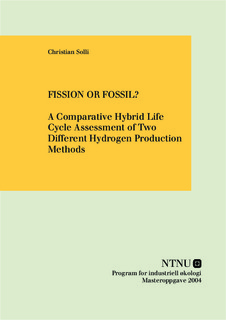| dc.contributor.author | Solli, Christian | nb_NO |
| dc.date.accessioned | 2014-12-19T12:34:51Z | |
| dc.date.available | 2014-12-19T12:34:51Z | |
| dc.date.created | 2007-02-27 | nb_NO |
| dc.date.issued | 2004 | nb_NO |
| dc.identifier | 122126 | nb_NO |
| dc.identifier.uri | http://hdl.handle.net/11250/242613 | |
| dc.description.abstract | A comparative hybrid life cycle assessment was conducted to assess two different methods for hydrogen production. Environmental impacts from nuclear assisted thermochemical water splitting are compared to hydrogen production from natural gas steam reforming with CO2-sequestration. The results show that the two methods have significantly different impacts. The nuclear alternative has lower impacts on global warming potential, acidification and eutrophication, but very much higher for some of the other impact categories. A weighting procedure is not applied, hence no overall ”winner” can be proclaimed. The different impacts relative importance remains a challenge for eventual decision makers.
Further the assessment has demonstrated the importance of including economic inputs in a comparative assessment; ordinary process-LCA may produce distorted results since a larger fraction of impacts can be accounted for in one case than in another.
Another analytical finding is that avoiding double counting of material inputs in the input-output part of the assessment, significantly affects the results of some impact categories. A procedure to avoid double counting should therefore always be applied when performing a hybrid LCA. | nb_NO |
| dc.language | eng | nb_NO |
| dc.publisher | Institutt for energi- og prosessteknikk | nb_NO |
| dc.title | Fission or Fossil?: A Comparative Hybrid Life Cycle Assessment of Two Different Hydrogen Production Methods | nb_NO |
| dc.type | Master thesis | nb_NO |
| dc.contributor.department | Norges teknisk-naturvitenskapelige universitet, Fakultet for ingeniørvitenskap og teknologi, Program for industriell økologi | nb_NO |
